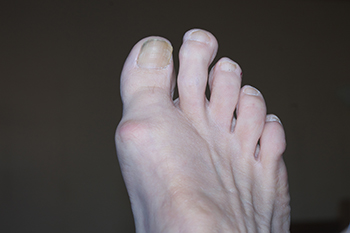Connect With Us
Blog
Items filtered by date: March 2025
We Can Treat Your Foot or Ankle Pain
What Is Morton's Toe?

Morton's toe is a foot condition where the second toe is longer than the big toe due to a shorter first metatarsal bone. This structural difference can alter weight distribution, placing extra pressure on the ball of the foot. Causes of Morton's toe are primarily genetic, as the condition is inherited. This imbalance can lead to foot problems like calluses, metatarsalgia, and improper arch support. It may also contribute to pain in the ankles, knees, and lower back due to changes in walking mechanics. Relief options include wearing shoes with proper arch support, using orthotic inserts, and choosing footwear with a roomy toe box. If this condition is causing you discomfort, it is suggested that you consult a podiatrist who can guide you on relief options, including stretching and strengthening exercises that can help improve foot stability.
Congenital foot problems require immediate attention to avoid future complications. If you have any concerns, contact Melissa C. Verde, DPM of Florida. Our doctor can provide the care you need to keep you pain-free and on your feet.
Congenital foot problems are deformities affecting the feet, toes, and/or ankles that children are born with. Some of these conditions have a genetic cause while others just happen. Some specific foot ailments that children may be born with include clubfeet, polydactyly/macrodactyly, and cleft foot. There are several other foot anomalies that can occur congenitally. What all of these conditions have in common is that a child may experience difficulty walking or performing everyday activities, as well as trouble finding footwear that fits their foot deformity. Some of these conditions are more serious than others. Consulting with a podiatrist as early as possible will help in properly diagnosing a child’s foot condition while getting the necessary treatment underway.
What are Causes of Congenital Foot Problem?
A congenital foot problem is one that happens to a child at birth. These conditions can be caused by a genetic predisposition, developmental or positional abnormalities during gestation, or with no known cause.
What are Symptoms of Congenital Foot Problems?
Symptoms vary by the congenital condition. Symptoms may consist of the following:
- Clubfoot, where tendons are shortened, bones are shaped differently, and the Achilles tendon is tight, causing the foot to point in and down. It is also possible for the soles of the feet to face each other.
- Polydactyly, which usually consists of a nubbin or small lump of tissue without a bone, a toe that is partially formed but has no joints, or an extra toe.
- Vertical talus, where the talus bone forms in the wrong position causing other bones in the foot to line up improperly, the front of the foot to point up, and the bottom of the foot to stiffen, with no arch, and to curve out.
- Tarsal coalition, when there is an abnormal connection of two or more bones in the foot leading to severe, rigid flatfoot.
- Cleft foot, where there are missing toes, a V-shaped cleft, and other anatomical differences.
- Macrodactyly, when the toes are abnormally large due to overgrowth of the underlying bone or soft tissue.
Treatment and Prevention
While there is nothing one can do to prevent congenital foot problems, raising awareness and receiving neonatal screenings are important. Early detection by taking your child to a podiatrist leads to the best outcome possible.
If you have any questions please feel free to contact our office located in Longwood, FL . We offer the newest diagnostic tools and technology to treat your foot and ankle needs.
Treatment Options for Morton’s Neuroma

Morton's neuroma develops when tissue thickens around a nerve in the forefoot, commonly between the third and fourth toes. This condition often causes a burning sensation, tingling, or the feeling of stepping on a small object. Wearing tight shoes and high heels can increase pressure on the nerve and worsen the pain. A podiatrist can diagnose Morton’s neuroma by assessing symptoms and using digital imaging as needed. Treatment may involve changing footwear, using orthotics to relieve pressure, or receiving injections to reduce inflammation. If non-surgical methods do not provide relief, surgery may be considered to either remove the affected nerve or release surrounding tissue to reduce compression. Surgical recovery typically allows walking in a protective shoe soon after the procedure, with most people returning to regular footwear within a few weeks. If you are experiencing symptoms of Morton's neuroma, it is suggested that you schedule an appointment with a podiatrist for an exam, diagnosis, and treatment options, which may include surgery.
Morton’s neuroma is a very uncomfortable condition to live with. If you think you have Morton’s neuroma, contact Melissa C. Verde, DPM of Florida. Our doctor will attend to all of your foot care needs and answer any of your related questions.
Morton’s Neuroma
Morton's neuroma is a painful foot condition that commonly affects the areas between the second and third or third and fourth toe, although other areas of the foot are also susceptible. Morton’s neuroma is caused by an inflamed nerve in the foot that is being squeezed and aggravated by surrounding bones.
What Increases the Chances of Having Morton’s Neuroma?
- Ill-fitting high heels or shoes that add pressure to the toe or foot
- Jogging, running or any sport that involves constant impact to the foot
- Flat feet, bunions, and any other foot deformities
Morton’s neuroma is a very treatable condition. Orthotics and shoe inserts can often be used to alleviate the pain on the forefront of the feet. In more severe cases, corticosteroids can also be prescribed. In order to figure out the best treatment for your neuroma, it’s recommended to seek the care of a podiatrist who can diagnose your condition and provide different treatment options.
If you have any questions, please feel free to contact our office located in Longwood, FL . We offer the newest diagnostic and treatment technologies for all your foot care needs.
Facts About Foot Stress Fractures

Foot stress fractures are tiny hairline cracks in bones caused by repeated stress, especially common in the metatarsal bones of the feet. They are caused by activities involving frequent running, jumping, or dancing. Stress fractures, which are considered to be an overuse injury, lead to pain during physical activity, swelling, bruising, and tenderness when touched. Because stress fractures in the metatarsal bones are not easily detected through standard X-rays, a podiatrist may order advanced imaging, like a bone scan, for an accurate diagnosis. Treatment generally involves resting the affected area, using supportive devices like casts or protective footwear, or possibly surgery to ensure proper bone healing. Preventing metatarsal stress fractures includes gradually increasing activity levels and avoiding pushing through pain, which can result in further injury or prolonged recovery. If you suspect you have sustained a metatarsal foot stress fracture, it is suggested that you schedule an appointment with a podiatrist for an exam, diagnosis, and treatment.
Stress fractures occur when there is a tiny crack within a bone. To learn more, contact Melissa C. Verde, DPM from Florida. Our doctor can provide the care you need to keep you pain free and on your feet.
How Are They Caused?
Stress fractures are the result of repetitive force being placed on the bone. Since the lower leg and feet often carry most of the body’s weight, stress fractures are likely to occur in these areas. If you rush into a new exercise, you are more likely to develop a stress fracture since you are starting too much, too soon. Pain resulting from stress fractures may go unnoticed at first, however it may start to worsen over time.
Risk Factors
- Gender – They are more commonly found in women compared to men.
- Foot Problems – People with unusual arches in their feet are more likely to develop stress fractures.
- Certain Sports – Dancers, gymnasts, tennis players, runners, and basketball players are more likely to develop stress fractures.
- Lack of Nutrients – A lack of vitamin D and calcium may weaken the bones and make you more prone to stress fractures
- Weak Bones – Osteoporosis can weaken the bones therefore resulting in stress fractures
Stress fractures do not always heal properly, so it is important that you seek help from a podiatrist if you suspect you may have one. Ignoring your stress fracture may cause it to worsen, and you may develop chronic pain as well as additional fractures.
If you have any questions, please feel free to contact our office located in Longwood, FL . We offer the newest diagnostic and treatment technologies for all your foot care needs.
Arthroscopic Surgery for Ankle Repair

Arthroscopic ankle surgery is a minimally invasive procedure that allows a podiatrist to diagnose and repair damaged tissues in the ankle joint. Using a small camera called an arthroscope, the podiatrist can assess the condition of bones, cartilage, ligaments, and tendons through small incisions. This method is commonly used to treat ligament tears, loose bone or cartilage fragments, and scar tissue that may be causing pain or limiting movement. Ankle arthroscopy can also help reduce discomfort caused by arthritis or impingement, where swollen tissues restrict joint motion. The procedure involves inserting surgical instruments through additional small incisions to repair or remove damaged structures. Compared to open surgery, arthroscopy generally results in less pain and a shorter recovery time. However, healing can vary depending on the severity of the damage and the extent of the repair. A podiatrist can evaluate whether arthroscopic ankle surgery is appropriate and provide guidance on the recovery process. If you would like more information about arthroscopic ankle repair, it is suggested that you schedule an appointment with a podiatrist for an exam and treatment options.
Ankle pain can be caused by a number of problems and may be potentially serious. If you have ankle pain, consult with Melissa C. Verde, DPM from Florida. Our doctor will assess your condition and provide you with quality foot and ankle treatment.
Ankle pain is any condition that causes pain in the ankle. Due to the fact that the ankle consists of tendons, muscles, bones, and ligaments, ankle pain can come from a number of different conditions.
Causes
The most common causes of ankle pain include:
- Types of arthritis (rheumatoid, osteoarthritis, and gout)
- Ankle sprains
- Broken ankles
- Achilles tendonitis
- Achilles tendon rupture
- Stress fractures
- Bursitis
- Tarsal tunnel syndrome
- Plantar fasciitis
Symptoms
Symptoms of ankle injury vary based upon the condition. Pain may include general pain and discomfort, swelling, aching, redness, bruising, burning or stabbing sensations, and/or loss of sensation.
Diagnosis
Due to the wide variety of potential causes of ankle pain, podiatrists will utilize a number of different methods to properly diagnose ankle pain. This can include asking for personal and family medical histories and of any recent injuries. Further diagnosis may include sensation tests, a physical examination, and potentially x-rays or other imaging tests.
Treatment
Just as the range of causes varies widely, so do treatments. Some more common treatments are rest, ice packs, keeping pressure off the foot, orthotics and braces, medication for inflammation and pain, and surgery.
If you have any questions, please feel free to contact our office located in Longwood, FL . We offer the newest diagnostic and treatment technologies for all your foot care needs.

